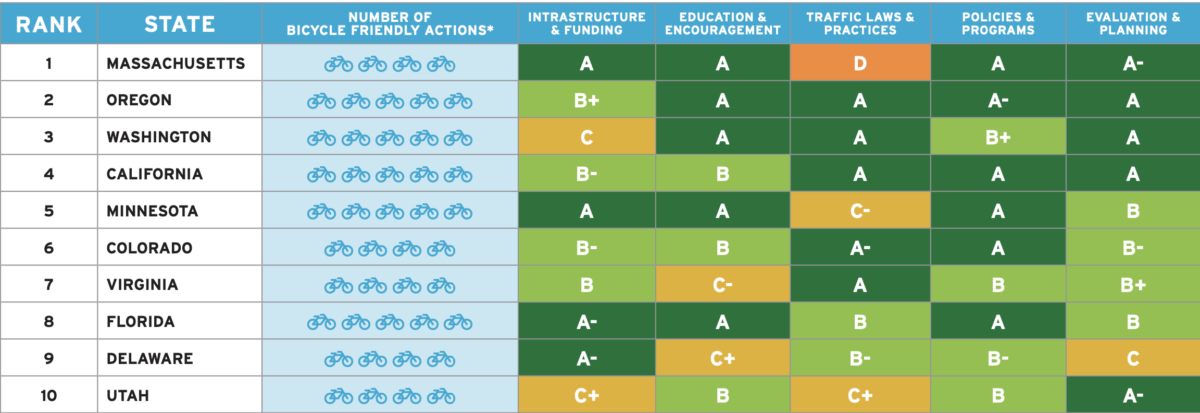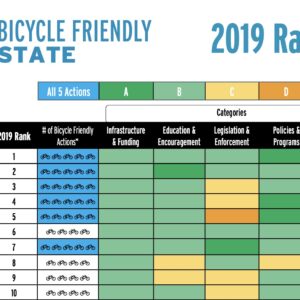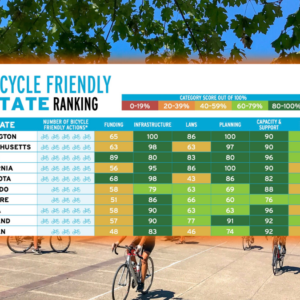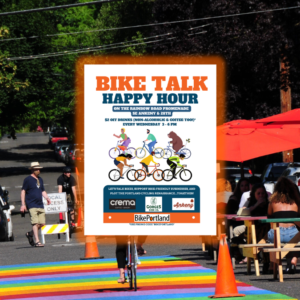
According to The League of American Bicyclists, which recently released its 2022 list of the most bike friendly states, Oregon is the second most bike friendly state in the United States, coming in right behind Massachusetts. We made second place the last time the League published their rankings in 2019, when we were beaten out by Washington.
Speaking of Washington, our neighbor to the north slipped from its first place placement for the first time since the League started publishing these rankings, this year coming right behind us at third place. (Psst: while we enjoy a little friendly Pacific Northwest rivalry, keep it between the Ducks and the Huskies. We want to see all states succeed when it comes to biking.) California and Minnesota came in at fourth and fifth respectively.
The rankings are determined based on five factors, which are outlined below. Here’s how our report card looked:
Oregon is one of 10 states to have adopted all five of the League’s ‘bike friendly actions,’ which include a Complete Streets policy, a safe passing law, a statewide bike plan, spending 2% or more of federal transportation money on biking and walking and having a bicycle safety emphasis area.
Oregon comes in at first place nationally for bike commuting mode share, as almost 2% of commuters bike to work here. This number is higher in cities like Portland, Eugene and Corvallis (the last of which beat Portland handily as Oregon’s top city for bike commuting in 2020), and we’d like it to be higher statewide, but considering how rural much of Oregon is, coming in first place here is nothing to scoff at.
Advertisement
Despite doing so well overall, the League did provide some ideas of how we can improve in their individual state report for Oregon. These suggestions are things Portland bike advocates talk about often, like how we need to increase mode share in non-emitting modes of transportation like biking and walking, and that “reducing or increasing scrutiny of projects to increase motor vehicle capacity will be key to achieving reductions in greenhouse gas emissions.” With multiple anti-freeway campaigns taking place in Portland right now, there is certainly the people power to make this happen.
The League praises Oregon’s bold commitments to climate action, but also says leadership needs to act to reduce transportation-related greenhouse gas emissions in order to actually meet those goals.
In fact, the League calls out the Oregon Department of Transportation by name, saying they’ve had “high-profile opportunities for cultural changes at the agency” but haven’t acted on those opportunities as they should.
“As a national leader in bicycling and walking, how the Oregon DOT and other partners navigate these changes can have national impacts. The League hopes to see positive cultural changes that embrace equity, communities, and active transportation gain momentum moving forward,” the report says.
Advertisement
Taking a 10,000 foot view, this report shows some national improvements, stating there has been a “marked increase” in bicycle friendly actions over the last 10 years.
“We found many states answering the call to design safer streets for all people. The League of American Bicyclists congratulates every state that is taking action to improve the safety and experience of people bicycling. Since 2015, we have seen the number of states taking all five of our recommended Bicycle Friendly Actions nearly double,” the League reports.
It’s good to see national trends indicating biking and bike safety is on the rise. There has been much ado about the ‘pandemic bike boom,’ and with this report, it looks like leadership is at least attempting to meet the demand.
Since I’ve lived in Oregon for so long, it’s hard for me to remember what biking anywhere else was like, and I think I take it for granted how nice it is to bike here. That being said, we can acknowledge we’re doing a comparably great job while still holding our leadership accountable.
You can read the whole report here and find out more about how the League suggests leaders act on making their states more bike-friendly.







Thanks for reading.
BikePortland has served this community with independent community journalism since 2005. We rely on subscriptions from readers like you to survive. Your financial support is vital in keeping this valuable resource alive and well.
Please subscribe today to strengthen and expand our work.
So Oregon has 3 A’s, 1 A-, and 1 B+ while Massachusetts has 3 A’s, 1 A-, and 1 D. I guess I’m not understanding how that puts Massachusetts in first place and Oregon in second… If there are subjective factors that favor Massachusetts, that’s understandable, but then why have a rubric like this?
I agree with you, it’s definitely weird. I was also confused and probably should’ve made a note of that. I don’t know the answer for sure, but in the reports they focus a lot on MA’s Covid-related response – how they were particularly good at using the pandemic as an opportunity to create open street programs and remove cars from the roads.
I think the other thing might be the leadership in MA – in the MA state report it says the state is particularly well-positioned to improve biking through IIJA funding. Perhaps they don’t think ODOT is stepping it up as much? Either way, I agree the grading is kind of confusing and would probably take it with a grain of salt. The more objective data are what to keep an eye on.
In a similar vein, why does Florida with much higher scores have a lower rank than Virginia? There is a definite bias built into the ratings.
I thought the same thing; but maybe each category is weighted, in order of importance.
Sorry but this data looks cooked, like other many other things these days. Living deep out in east PDX riding a bike feels like a death sentence. I live out past Glendoveer park and streets like Halsey and Glisan have become freeways with ZERO enforcement. And don’t get me started with 122nd. it’s to the point my partner is actually to the point of begging me not to ride anymore. Riding a bike used to be fun. Now it’s a stressful chore. Even with the cost of gas, I’m thinking of just saying fuck it dusting off the old Civic.
You may not have lived and cycled in other states, Taylor, but I certainly have. It’s true that cycling in Oregon is among the best in the country (I’d argue that California has a slight edge – much better and more consistent infrastructure than Oregon). But it’s like bragging that you are the tallest skyscraper in Topeka, Kansas: not that big of an achievement, really.
Those of us who cycle in Oregon know just how much better cycling here COULD be. Really what the report shows is not how great cycling is here but how absolutely abysmal it is in the US generally.
This goes beyond cycling to many aspects of city infrastructure and governance. If we want to be a great city then we should be looking abroad for our competition, and inspiration. It’s easy to beat dysfunctional American cities, it’s a much greater challenge to beat other wealthy cities in East Asia and Europe.
Throwin’ shade on the Topeka Tower… but I get your point.
Having trouble taking this seriously seeing FL in the top 10.
Feels like the league has a really low bar for biking infrastructure. Perhaps they should compare these states to North European countries and lower the grades by a lot.
So you want to compare European countries to US states? Is that really an apples-to-apples comparison? Even if you wanted to compare European cities to US cities, we could make a long list of social, political, geographical, etc. differences that make that comparison irrelevant.
Unlike many people here, I believe these types of rankings are based on what things exist and is not about looking at what does not exist, other than saying what could make things better. I think it’s fair to say that there will always be places in any city that are uncomfortable/unsafe to ride. Rather than refusing to ride, find the places that are fun to ride. The more you ride the more comfortable you will become and you will find more places to ride. It’s the beauty of bike riding.
This rating system is absurd. Just ask 500 random cyclists what they think. Especially the many who have given up riding on public roads over the past decade. The deterioration in consideration of cyclists’ safety in law enforcement and road design is endemic. I live in Bend, but I assume it is the same elsewhere. Roundabouts (which should probably be re-named cyclist meatgrinders) have exploded and I have never, I mean never, gotten a police officer to issue a citation in the countless incidents I have witnessed and attested to. Maybe I’ll call my friend’s wife who was hit in Eugene over the weekend, and ended up with extensive and serious injuries, and ask her how she feels about riding in Oregon.
Roundabouts are fine and there’s more predictability going through them compared to other intersections. True that there’s almost zero traffic law enforcement here.
oi, if we’re in second place, I’d absolutely hate to bike anywhere else.